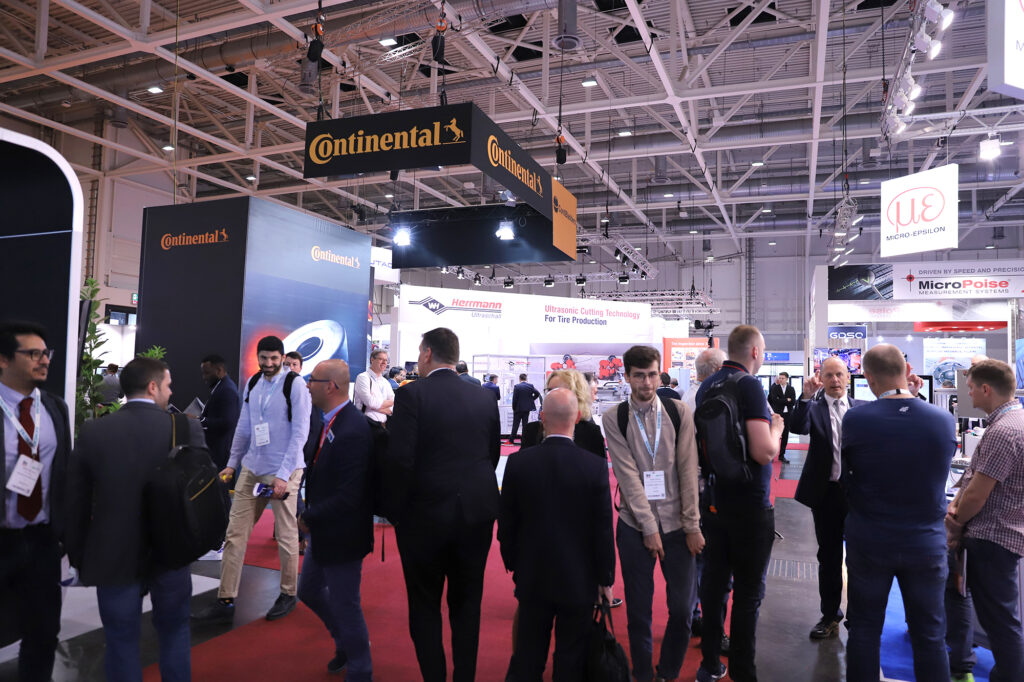Day 2 at Tire Technology Expo continues to see strong attendance, with visitors able to check out new launches and innovations across the floor, while the previous evening saw the winners announced for this year’s Tire Technology International Awards for Innovation and Excellence.
Pneumatic conveying system increases energy efficiency of production lines
Italian company NTE Process is exhibiting its latest dense phase pneumatic conveying system with Air Assist at Tire Technology Expo 2022. The system uses a reduced amount of compressed air to convey large quantities of raw materials needed for tire production, such as carbon black and silica. Air is injected at strategic positions along the pipeline to convey regular slugs of product. Depending on the facility, the materials are moved from rails, bags or tracks into storage silos at the beginning of the process before being transported into mixing machines.
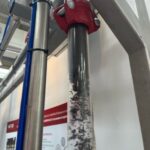 By utilizing the Air Assist technology, material handling companies can control the air pressure, speed and rate at which materials are transported, in addition to reducing the amount of air used. This ensures that fragile or abrasive products are moved slowly and reduces the chance of materials clogging up the system. The system also prevents problems associated with traditionally used systems, such as high pressure in the line, the inability to control the conveying phase and a very high final expansion of the air, which can result in high product speeds and the possibility of damaged materials.
By utilizing the Air Assist technology, material handling companies can control the air pressure, speed and rate at which materials are transported, in addition to reducing the amount of air used. This ensures that fragile or abrasive products are moved slowly and reduces the chance of materials clogging up the system. The system also prevents problems associated with traditionally used systems, such as high pressure in the line, the inability to control the conveying phase and a very high final expansion of the air, which can result in high product speeds and the possibility of damaged materials.
“The revolutionary Air Assist utilizes artificial intelligence technology to recognize when it is necessary for air to push [materials], or when it is not necessary for the air to push [materials],” commented Giuseppe Furfaro, a business developer at NTE Process. “This helps in two ways: to not break the material and also to reduce the consumption of air, which is very important.”
Nanofilament-based carbon black alternative reduces compound degradation
 CarbonX is presenting its carbon black alternative at Tire Technology Expo. The company’s new carbon material is composed of nano-sized carbon filaments that are chemically connected to form a three-dimensional micron-sized network. The strong structure can be processed very easily without breaking down, keeping the performance of the rubber compound at an optimum level. This enables properties to be combined in new ways, resulting in design possibilities that can deliver high performance and improved sustainability when utilized in tire tread compounds.
CarbonX is presenting its carbon black alternative at Tire Technology Expo. The company’s new carbon material is composed of nano-sized carbon filaments that are chemically connected to form a three-dimensional micron-sized network. The strong structure can be processed very easily without breaking down, keeping the performance of the rubber compound at an optimum level. This enables properties to be combined in new ways, resulting in design possibilities that can deliver high performance and improved sustainability when utilized in tire tread compounds.
Features of CarbonX include pore structures inside the aggregates that are big enough for the polymers to get in, resulting in better filler/polymer interaction and improved end properties.
Aggregates within the tire – in the micro size range – deliver greater processability to stop small aggregates from making the compound more viscous.
“All of these things combined together translate into tire performance and enable us to break what is called the magic triangle. We can improve rolling resistance, abrasion and grip,” commented Vincenzo Roberto Calderone, head of marketing at CarbonX.
“The benefit it will bring when used within tires is during the use phase. For ICE and EV tires, most of the sustainability comes from the amount of CO2 you can save in the use phase, because you are burning fuel or the electricity comes from not 100% renewable stocks, so you still have to pay a CO2 price,” added Calderone. “If you are able to make your tire more efficient in terms of energy or fuel, you will benefit in terms of CO2 emissions. This is the gain in sustainability that we provide to the tire business.”
Kraiburg Austria has produced a tire compound using a CarbonX formulation without traditionally used carbon black and silica. Reifen Hinghaus used the compound to manufacture a retreaded summer tire that is also on show at the expo. Compared with conventional tire compounds, the new compound resulted in a 9% improvement in rolling resistance and a 2% improvement in abrasion resistance. Wet grip was improved by 7% and dry grip by 25%.
“During production there was no real property loss, unlike normal carbon blacks, which can have a good result in the laboratory but end with a drop in performance once the tire is produced,” explained Kris Sierkstra, a business developer at CarbonX. “We didn’t experience this; our lab results were good and so were our factory-scale results.”
Ultrasonic tire cutting technology reduces maintenance costs
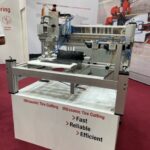 Herrmann Ultraschall is showcasing its latest Ultrasonic Cutting Technology at Tire Technology Expo. The company has unveiled an ultrasonic tire cutting machine that features a specially designed cutting tool capable of vibrating 20,000 times per second. Unlike standard mechanical cuts where tooling wears out quickly and has to be replaced, the Ultrasonic Cutting Technology makes gentle, angled micro cuts during tire production, resulting in a tooling lifespan of more than two years.
Herrmann Ultraschall is showcasing its latest Ultrasonic Cutting Technology at Tire Technology Expo. The company has unveiled an ultrasonic tire cutting machine that features a specially designed cutting tool capable of vibrating 20,000 times per second. Unlike standard mechanical cuts where tooling wears out quickly and has to be replaced, the Ultrasonic Cutting Technology makes gentle, angled micro cuts during tire production, resulting in a tooling lifespan of more than two years.
“Standard mechanical tools have to be replaced often. For this reason, it is very economical to use this technology,” explained Markus Haas, sales director for plastics in Asia at Herrmann Ultraschall. “We went to the extreme and used the best functioning [tooling] for a long lifetime, because then you don’t have to worry about your production and you know it is working. We verified this with a customer and after two-and-a-half years he is using the same tool. There is a lot of money saving [as] the cost per cut gets down to zero.”
Haas added, “We learned about the potential for rubber cutting when walking through the show two years ago and I said we should invest more brainpower into this [technology]. So, we created a testbed and analyzed [ways to] make the process more reliable and more stable.”
Automation increases efficiency of hardness testing
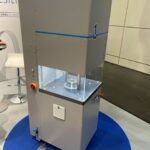 Bareiss is exhibiting its latest range of hardness, resistance, resilience and abrasion testers at Tire Technology Expo. On its booth is a fully automatic tabletop electronic device with interchangeable heads to measure Shore A, RHD normal and RHD micro hardness. Other company technologies include ball rebound testers and systems capable of conducting hardness testing in temperature chambers between -70°C and +180°C.
Bareiss is exhibiting its latest range of hardness, resistance, resilience and abrasion testers at Tire Technology Expo. On its booth is a fully automatic tabletop electronic device with interchangeable heads to measure Shore A, RHD normal and RHD micro hardness. Other company technologies include ball rebound testers and systems capable of conducting hardness testing in temperature chambers between -70°C and +180°C.
Bareiss’s latest system – the Rubber Process Analyzer (RPA) Ultra – is also on show. It enables engineers and companies to analyze processes and characterize materials, beginning with polymers, rubber and rubber compounds.
In addition to performing oscillatory testing over a wide range of frequencies (10-3 Hz to 100Hz) and strains, the RPA supplies a continuous shear rate in full rotation from 10-3s-1 to 500s-1.
“The system is unique because normal RPAs just oscillate, while ours is a closed-cavity rheometer that can also fully rotate,” explained Oliver Wirth, head of engineering at Bareiss. “Therefore, you can [conduct] steady shear measurements that are very closely related to the processability of rubber compounds.”
Robotic lubrication system helps accelerate tire fitting processes
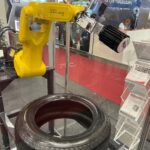 Micro-Poise Measurement Systems is presenting its ITMS RoboLube at this year’s Tire Technology Expo, a robotic system to lubricate the tire bead before it is fitted to a rim. Previously, the lubricating brush came from beneath the tire and made contact with the bead while the tire was rotated. This almost constant rotation of the system meant that the spin bed and omni rollers required frequent replacement, maintenance and cleaning. Instead, Micro-Poise Measurement Systems’ ITMS RoboLube utilizes a robotic arm that moves around a stationary tire to lubricate it, reducing maintenance costs and system downtime.
Micro-Poise Measurement Systems is presenting its ITMS RoboLube at this year’s Tire Technology Expo, a robotic system to lubricate the tire bead before it is fitted to a rim. Previously, the lubricating brush came from beneath the tire and made contact with the bead while the tire was rotated. This almost constant rotation of the system meant that the spin bed and omni rollers required frequent replacement, maintenance and cleaning. Instead, Micro-Poise Measurement Systems’ ITMS RoboLube utilizes a robotic arm that moves around a stationary tire to lubricate it, reducing maintenance costs and system downtime.
To collect tire data and increase efficiency, the company has placed a barcode reader on the end of the robotic arm to ensure a high level of accuracy when taking measurements. Traditionally, barcode readers have been placed up to 1.2m above the tire, which can cause measuring inaccuracies.
“All of the measuring data for uniformity, geometry and imbalance is added to the barcode,” explained Harry Vos, aftermarket sales manager EMEA at Micro-Poise Measurement Systems.
Intelligent and fully automatic solid tire press conducts multiple tasks
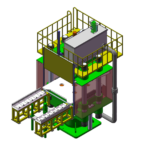 Qingdao Xiangjie Rubber Machinery has unveiled details of the company’s latest intelligent solid tire press at Tire Technology Expo. The system benefits from fully automatic intelligent mold and solid tire removal, and raw tire storage. This solution replaces manual operations previously used in production process with intelligent manipulators and an AGV Trolley.
Qingdao Xiangjie Rubber Machinery has unveiled details of the company’s latest intelligent solid tire press at Tire Technology Expo. The system benefits from fully automatic intelligent mold and solid tire removal, and raw tire storage. This solution replaces manual operations previously used in production process with intelligent manipulators and an AGV Trolley.
The AGV trolley and the ground-rail type tire pick-and-place auxiliary device is capable of fully automated loading, unloading and material handling processes. Automatic fitting and detection for abnormalities are also conducted in tandem, improving efficiency and product quality, while also optimizing industrial processes.
Qingdao Xiangjie Rubber Machinery’s solid tire curing workshop can run independently because of the pick-and-place auxiliary machine which cooperates with multi-sensors to ensure the precise positioning of the vulcanizer – each auxiliary machine can support 10 tire vulcanizers. Furthermore, the AGV trolley benefits from an autonomous navigation function which enables the handling of solid tires and semi-finished products in multi-task environments.


